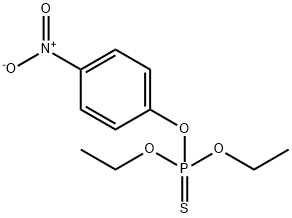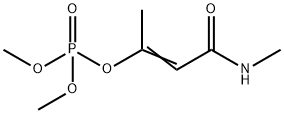Parathion-methyl solution , analyticalstandard,100ug/mlinacetone , 298-00-0
Synonym(s):
O,O-Dimethyl O-(4-nitrophenyl) phosphorothioate;Methyl parathion
CAS NO.:298-00-0
Empirical Formula: C8H10NO5PS
Molecular Weight: 263.21
MDL number: MFCD00041813
EINECS: 206-050-1
PRODUCT Properties
| Melting point: | 36°C |
| Boiling point: | 143°C (1.0 mmHg) |
| Density | 1.36 |
| vapor pressure | 4.1×10-4 Pa (20 °C) |
| refractive index | nD25 1.5367 |
| Flash point: | 46.1°C |
| storage temp. | APPROX 4°C |
| solubility | Chloroform: Slightly Soluble,Methanol: Slightly Soluble |
| form | solid |
| Water Solubility | 0.005 g/100 mL |
| BRN | 8905814 |
| Stability: | Stable. Flammable. |
| CAS DataBase Reference | 298-00-0(CAS DataBase Reference) |
| IARC | 3 (Vol. 30, Sup 7) 1987 |
| NIST Chemistry Reference | Phosphorothioic acid, o,o-dimethyl-o-p-nitrophenyl ester(298-00-0) |
| EPA Substance Registry System | Methyl parathion (298-00-0) |
Description and Uses
Methyl parathion is an organophosphate insecticide. It is converted into an oxon-containing metabolite in vivo, similar to other organophosphate pesticides, that inhibits acetylcholinesterase. Methyl parathion is lethal to lab strains and field isolates of tobacco budworm larvae (LD50s = 7 and 81.8-128.3 μg/g, respectively). It reduces the number of stink bugs (C. sayi) caught per 100 net sweeps when applied to alfalfa fields at a concentration of 0.4 pounds per acre. Methyl parathion increases sister chromatid exchange (SCE) in a concentration-dependent manner and induces cell cycle arrest at the M1 phase in V79 cells at a concentration of 40 μg/ml. It is toxic to rats (LD50 = 14 mg/kg).
Parathion-methyl is an derivative of Parathion (P192220), an organophosphate insecticide used on cotton, rice and fruit trees.
Safety
| Symbol(GHS) |    GHS06,GHS08,GHS09 |
| Signal word | Danger |
| Hazard statements | H300+H330-H311-H373-H410 |
| Precautionary statements | P260-P273-P280-P302+P352+P312-P304+P340+P310-P314 |
| Hazard Codes | T+;N,N,T+,Xn,F |
| Risk Statements | 5-24-26/28-48/22-50/53-10-67-66-51/53-36-20/22-11-65-38 |
| Safety Statements | 28-36/37-45-60-61-26-62-16 |
| RIDADR | UN 2052/2783/2811 |
| OEB | C |
| OEL | TWA: 0.2 mg/m3 [skin] |
| WGK Germany | 3 |
| RTECS | TG0175000 |
| HazardClass | 6.1(a) |
| PackingGroup | II |
| HS Code | 29201100 |
| Hazardous Substances Data | 298-00-0(Hazardous Substances Data) |
| Toxicity | LD50 in male, female rats (mg/kg): 14, 24 orally; 67, 67 dermally (Gaines) |




